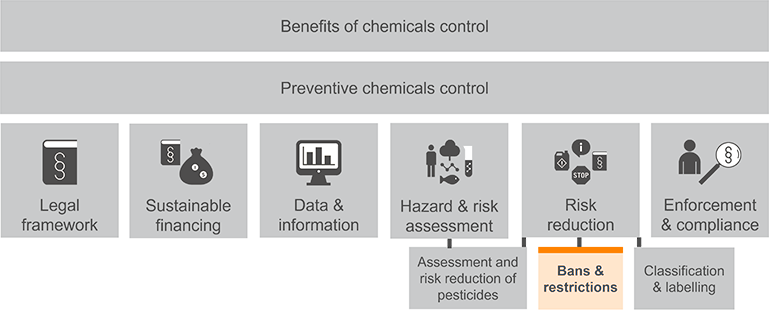Bans and restrictions of hazardous chemicals
Use of the most hazardous chemicals needs to be limited to protect human health and the environment from negative effects. Introduction of bans and restrictions is one way to achieve this.
Need for bans or restrictions
Certain substances can be considered too hazardous or give rise to risks too great to be used at all, and some can only be used subject to restrictions. There are different instruments to control the placing on the market and the use of such substances which all aim at more or less far-reaching limitations on the production, placing on the market, or use of the substance as such, in mixtures, or in articles.
Introducing bans and restrictions
Banning the production, import and use of a chemical or restricting its use in certain applications can be introduced at all stages of the chemical's lifecycle. The most far-reaching measure is to ban all production, import, and use of a substance, including in mixtures and articles. This type of ban is relevant to introduce when the hazard or the risk from the substance is high and especially if there are various sources giving rise to the risk, making it difficult to restrict each and every source.
There might be a need to allow a specific use of a substance that is considered essential to society and for which there are no alternatives yet. This can be done by introducing exemptions that can vary in their extent. Introducing this possibility can, in certain cases, create a greater acceptance of the ban.
Read more about introduction of bans and restrictions in our Guidance on risk reduction of chemicals, chapter 8.2.2.
International conventions banning and restricting chemicals
Through the Stockholm and Minamata Conventions and the Montreal Protocol, the international community has agreed to ban or severely restrict several substances worldwide. For countries that have signed and ratified conventions, it is an obligation to implement the agreed-upon decisions in their national legislation.
Read more about the Stockholm Convention
Read more about the Minamata Convention External link.
External link.
Read more about the Montreal Protocol External link.
External link.
National prioritisation of chemicals for bans and restrictions
In addition to the obligations of implementing a chemicals convention following its ratification, it is necessary for a country to consider the need for introducing further risk reduction measures for other chemicals not covered by the conventions but that nevertheless pose risks to human health or the environment at the national level. It is essential that basic legislation requires industry to take responsibility for the chemicals they produce, import, and use to reduce the risks to human health or the environment. However, it might be necessary for authorities to introduce measures towards certain substances or groups of substances to handle potential risks. These substances might be identified through actual cases of pollution and poisoning, but it is advisable to try to identify potentially problematic chemicals before any harm has occurred.
Read more about prioritisation of chemicals in our Guidance on risk reduction of chemicals, chapter 6.
Credits
Illustrations by Maja Modén.

